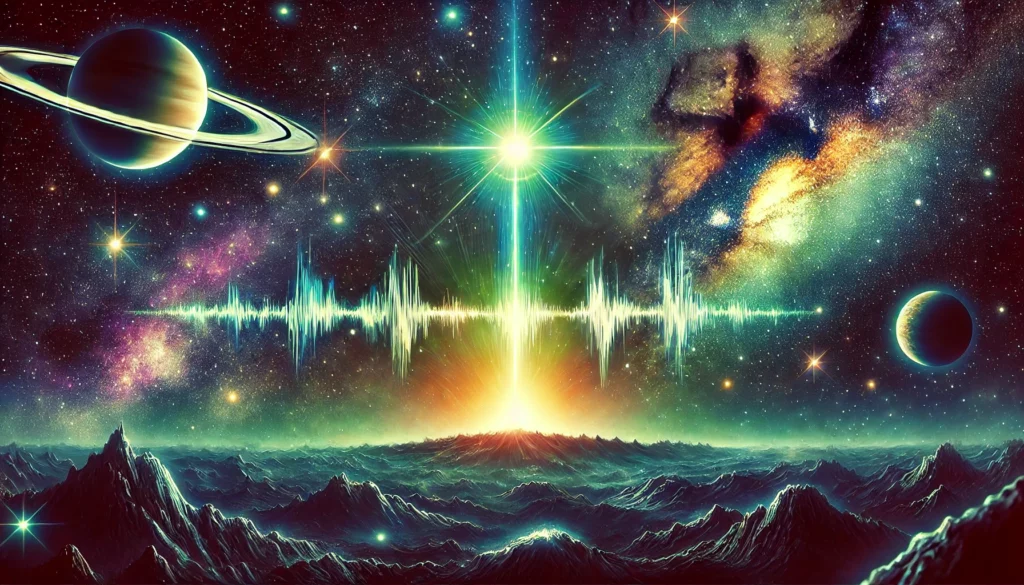
The Wow! Signal
One late night in the summer of 1977, a large radio telescope near Delaware, Ohio, captured something that, for a fleeting moment, seemed poised to alter the trajectory of human understanding forever. This telescope was part of a project scanning the cosmos for SETI, the Search for Extraterrestrial Intelligence. It intercepted a radio signal that fit the profile of a transmission from another world. Though it lasted only seventy-two seconds, that signal sparked momentous excitement and speculation.
Yet, days passed before anyone noticed. It wasn’t until Jerry Ehman, a scientist working with SETI, sifted through a stack of computer printouts from the telescope’s observations that the signal caught his eye. As he perused the endless sequence of low numbers — ones, twos, threes, and fours, all indicating the background noise typical of the universe’s natural hum — he stumbled upon something extraordinary. The telescope, sweeping across the sky, had locked onto a burst of radio waves so intense that the numbers on the printout abruptly switched to letters, climbing steadily all the way to “U.” This letter signified a signal thirty times stronger than the ambient cosmic noise.
The string of letters was unmistakable — an anomaly, perhaps even a message from an alien civilization. Startled by the discovery, Ehman encircled the letters in red ink and scribbled a single word in the margin: “Wow!”
And so, the most famous and mysterious signal in the brief history of SETI was born: The “Wow!” signal, a tantalizing hint at the possibility of otherworldly contact.

A New Theory Emerges
For nearly five decades, scientists have puzzled over this mysterious radio signal known as the “Wow! Signal.” Now, researchers from the Planetary Habitability Laboratory (PHL) at the University of Puerto Rico at Arecibo believe they may have finally cracked the case.
The team suggests that this enigmatic signal could have a natural origin, potentially resolving one of the most intriguing mysteries in the search for extraterrestrial intelligence.

The “Wow! Signal” had a high power, a narrow bandwidth (near the 1420 MHz hydrogen line), and a signal-to-noise ratio that set it apart from known natural phenomena. For this reason, this very artificial-looking radio signal was suspected to be a sort of message in a bottle beamed out into outer space by an advanced extraterrestrial civilization.
However, despite numerous attempts, the signal was never detected again, and its origin remained a mystery. Over the years, various theories have been proposed, ranging from interstellar communications to natural celestial events. However, none provided a definitive explanation. This has left scientists wondering if the “Wow! Signal” was a unique occurrence or an artifact of some unknown, exotic phenomenon.
Led by Professor Abel Méndez, the team from the PHL has proposed a new theory that might finally explain the “Wow! Signal.” Utilizing data from the now-collapsed Arecibo Observatory’s 305-meter telescope, along with more recent observations from a smaller 12-meter telescope, the researchers suggest that the signal could have been caused by a rare astrophysical event: the sudden brightening of a cold hydrogen cloud due to stimulated emission from a transient radiation source, such as a magnetar flare or a soft gamma repeater.
These types of cosmic events, although exceeding rare, can cause hydrogen clouds to emit narrowband radio signals that are much brighter than their usual faint emissions. The team hypothesizes that the “Wow! Signal” was a result of such an emission, possibly explaining why the signal was so strong and yet so fleeting.
“Our latest observations, made between February and May 2020, have revealed similar narrowband signals near the hydrogen line, though less intense than the original Wow! Signal,” said Méndez.
If this hypothesis is correct, it could significantly alter the direction of future searches for extraterrestrial intelligence. The study suggests that similar signals might be misinterpreted as artificial when they are actually natural astrophysical phenomena.
“Our hypothesis explains all observed properties of the Wow! Signal, proposes a new source of false positives in technosignature searches, and suggests that the Wow! Signal could be the first recorded event of an astronomical maser flare in the hydrogen line,” the team wrote in their paper.
Where We Go From Here
The researchers plan to continue their work by using more advanced telescopes, such as the Very Large Telescope in Chile, to identify the exact clouds responsible for the signals found in the archived data. This follow-up research could provide further evidence to support or refute their hypothesis.
While some may feel disappointed that the “Wow! Signal” might not be a direct communication from extraterrestrial beings, the findings open new avenues for understanding cosmic phenomena. As Professor Méndez pointed out, these results could still aid future efforts to detect extraterrestrial civilizations, especially around red dwarf stars with potentially habitable planets.
The team’s findings are currently available as a draft on their website and are set to undergo peer review soon. The scientific community eagerly awaits the results of these reviews and any subsequent studies that might confirm or challenge this latest explanation.
For now, the mystery of the “Wow! Signal” might be closer to resolution, but the universe still holds countless secrets. As researchers continue to explore the cosmos, the search for understanding — and perhaps even for life beyond Earth — goes on.






